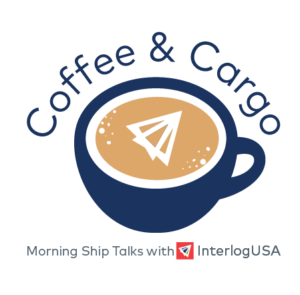Competitive Edge
March 30th, 2022
Stay Current with Interlog’s Weekly Newsletter:
Sign up for our next Coffee & Cargo webinar –> CLICK HERE
To watch last week’s webinar –-> CLICK HERE
Ocean Freight Market Update
Headlines
- The Load Star reports average vessel waiting times for berth and labor have improved significantly at the ports of Los Angeles and Long Beach in the past few weeks, halving the number of queueing ships to below 50.
- The South Carolina Ports Authority will no longer provide a timetable on when it will clear the more than two dozen vessels anchored outside the Port of Charleston because there are too many factors beyond its control, port officials told The Journal of Commerce.
- Courtesy of The Journal of Commerce, U.S. Secretaries of Transportation and Agriculture have both written letters to major ocean carriers urging for more calls to Oakland and Portland ports in efforts to assist U.S. agricultural exporters get their product overseas.
UPDATE: Notable U.S./Canada Port Congestion – as of 03/29/22
- Vancouver: 62 Backlogged Vessels
- Houston: 60 Backlogged Vessels
- Los Angeles/Long Beach: 48 Backlogged Vessels
- Norfolk/Newport News: 38 Backlogged Vessels
- Charleston: 27 Backlogged Vessels
- New York/Newark: 23 Backlogged Vessels
- Note: This does not include port-bound vessels waiting at ports of origin
IMPORT: Asia to North America (TPEB)
Recent Developments:
- Factory production in Shenzhen has moderately resumed as several COVID-related lockdown restrictions were steadily lifted.
- However, COVID-19 outbreaks and subsequent restrictions continue to pose disruptions to production and trucking activity for Shenzhen, Dongguan, and Shanghai.
- For more information, read the article in this newsletter below
- Fuel charges for TPEB lanes have increased.
- The usual suspects—severe congestion, deteriorating schedule integrity, port omissions, and blank sailings—remain contributors to an uncertain market.
Rates: Rate levels remain elevated. Premium market remains strong.
Space: Space remains critical and is expected to stay tight.
Capacity/Equipment: Capacity remains severely under. Equipment deficits remain critical.
TIPS: Book at least 4 weeks prior to CRD. Strongly consider premium service and carrier IPIs through the PSW gateway. Be flexible as it comes to equipment and routing. Be in contact with suppliers to check up on any COVID-related developments that can affect production.
IMPORT: Europe to North America (TAWB)
Recent Developments:
- USEC port congestion remains pronounced. New York and Savannah ports are managing relatively well and are operating regularly.
- USWC ports, notably Long Beach/Los Angeles, remain heavily congested with wait times only slightly improving—still averaging around 35 days.
Rates: Rates levels remain high. Rates will increase as GRIs and PSSs announced for March and April.
Space: Space is critical for USEC and USWC.
Capacity/Equipment: Capacity remains tight for both North Europe and Mediterranean services. Equipment availability at ports, however shortages remain at inland terminals.
TIPS: Book 5 or more weeks prior to CRD. Strongly consider premium service for higher reliability and no-roll guarantees.
EXPORT: North America to Asia
Recent Developments:
- Diminishing schedule integrity is contributing to void sailings, delays, vessel cut-offs at ports, and challenging post earliest return dates.
- For USEC, Port of Savannah operations have overall improved, however port omissions continue to adversely affect both Charleston and Savannah ports.
- Port of Charleston is also experiencing notable congestion.
- Vessel arrivals remain fluid for USWC POLs.
Rates: GRI activity (limited) announced for April.
Capacity: Available capacity remains fluid for USWC POLs.
Equipment: IPI origins remain adversely affected by deficits on containers and chassis. Standard equipment availability has not been an issue, but special equipment remains elusive.
TIPS: Book 4 to 6 weeks prior to CRD to secure equipment and vessel space.
Did You Know:
The USWC’s average share of U.S. imports from Asia dropped to it’s lowest (little over 58%) for January and February.
As the USEC’s average share of U.S. imports from Asia saw a record high (nearly 35%) for January and February.
Source: JOC
Freight News
Savannah harbor deepening has reached completion, the benefits this will provide the port
The Savannah harbor deepening has recently been completed. The deepening was designed to help improve and expediate the flow of cargo to and from global destinations. This deepening completion provides exporters more opportunities to move goods overseas, as the ships are able to take on more cargo. In addition, this will provide faster vessel service, which will help the Port of Savannah handle more ships each year. According to Freightwaves, this was a joint project between the Georgia Ports Authority and the U.S. Army Corps of Engineers and Georgia Department of Transportation.
This project was more than 20 years in the making as feasibility studies for the deepening began in 1997 and dredging to add 5 feet of depth to the shipping channel got underway in September of 2015, Freightwaves reports. With this harbor deepening, more than $291 million in annual benefits to the nation is expected, the Georgia Ports Authority announced in a Corps of Engineers study.
Another week, another lockdown...this time in Shanghai
A two-stage lockdown has begun in Shanghai beginning Monday, March 28th, which has the capability to cause weeks of disruptions for shippers in those regions and nearby. The first phase of these COVID measures issued by the government will apply to the eastern region of Shanghai from March 28th to April 1st, followed by the second phase which will target the western region of Shanghai from April 1st to April 5th – reports Freightwaves.
What we know so far:
Carriers have said that Shanghai’s main container terminals at Yangshan and Waigaoqiao are remaining open with vessel operations, yard handling, and gate-in/gate-out operating normally – however the biggest concern right now is many depots and warehouses are shut, with trucking severally limited, the Journal of Commerce reports. Because of the restrictions to factories, warehouses, and trucking, this will have a direct impact on how little cargo will go in or out of the port. Maersk has said that trucking capacity in Shanghai is expected to decrease by 30 percent as drivers have to either stay home to go through testing or are unable to enter the port districts because of the lockdowns.
If your manufacturing plant is outside Shanghai, a possible solution is to truck to outside ports. As warehouses in Shenzhen, Ningbo, Xiamen, and Qingdao are operating as of now.
This lockdown is also impacting air cargo as motor carriers are unable to use the roads to Shanghai Pudong airport – which is the main hub, reports Freightwaves. Few trucks are available and the amount of staff handling cargo at airports is quite limited too. Many are canceling flights to Shanghai already because of this.
We will be discussing this event and the aftermath in our April webinar. Please sign up today if you are interested.
Watch This Month's Webinar:

We discussed a variety of topics including: The delays in China, current port conditions, the CP railway strike & labor contract strikes, current events, and a Q&A with our experts!
Sign up for our
industry answers
Our team works to provide valuable, unique, and relevant content to assist you in finding solutions. Sign up now.
